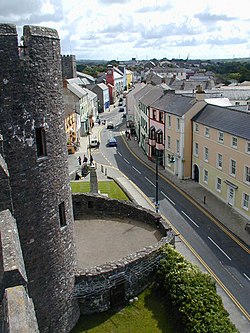Pembroke
| Pembroke Welsh: Penfro | |
| Pembrokeshire | |
|---|---|
 Pembroke Main Street from the castle | |
| Location | |
| Grid reference: | SM985015 |
| Location: | 51°40’34"N, 4°54’57"W |
| Data | |
| Population: | 7,214 (2001) |
| Post town: | Pembroke |
| Postcode: | SA71 |
| Dialling code: | 01646 |
| Local Government | |
| Council: | Pembrokeshire |
| Parliamentary constituency: |
Carmarthen West and South Pembrokeshire |
Pembroke is the county town of Pembrokeshire, standing on the headland which gives it its name. It is said that the town is named from the cantref of Penfro rather than the cantref from the town, but whichever came first the name is known to derive from the Welsh Penfro, meaning "land's head".[1]
The town is best known for the magnificent castle, Pembroke Castle; the remains of a stone mediæval castle which was the birthplace of King Henry VII of England.
Geography
Pembroke is located on a peninsula of Pembrokeshire, by the estuary of the River Cleddau. Pembroke town is located at the bottom of a small valley, flanked on all sides by woodland and arable farmland.
At the 2001 census, Pembroke had a population of 7,214, but the conurbation of Pembroke and Pembroke Dock may gather in nearly 16,000 souls and as such is one of the major population centres of West Wales.
History

The main point of interest in the town is the magnificent Pembroke Castle, the remains of a stone mediæval castle which was the birthplace of King Henry VII of England. Gerald de Windsor was Constable of Pembroke Pembroke town and castle and its surroundings are linked with the early Christian church. Later this was a stronghold of the Order of the Knights of St John.
Monkton Priory has very early foundations and was renovated by the Knights in the last century. The first stone building was a defensive tower, now known as the Mediæval Chapel, 69a Main Street, built on a cliff edge between the years 950 and 1000. There are the remains of a great hall to the north and recently filled-in arched cellars. The building was used as an early church. The layout is the same as St. Govan's Chapel and it was used by John Wesley from 1764 to preach Methodism. After Westgate Chapel was built we do not know what it was used for after 1810. In 1866 it became the Brewery for the York Tavern which was Oliver Cromwell's headquarters at the siege of Pembroke during the English Civil War.
On both banks of Pembroke River to the west of the castle are many remains of early activities. The buildings of Catshole Quarry and the rare vegetation with the irreplaceable foreshore have recently been buried by dumped materials. The North Shore Quarries are relatively complete as are the remains of mediæval and Elizabethan slipways where wooden vessels were built before the industrial Dockyard and Admiralty town was built on the grid pattern of Pembroke Dock.
There is a very early graving dock complete in what was Hancocks Yard, about to be buried by a massive infill of the mud flats to the North. The reclaimed land will be used to build high rise flats. The bridge which crosses and constrains the millpond was constructed to house a tide mill, originally granted to the Knights Templar in 1199[2] which survived until it was burnt down in 1956.
At Pennar flats the early submarine base used for experiments in submarine warfare has been recently bulldozed to allow speculative development by executive housing. Three of the houses on the then foreshore, part of the shipyard before the Admiralty Dock Yard was built, are still standing but are heavily altered.
The ferry port of Pembroke Dock is a separate town, which was established in 1814. It lies three miles to the north of Pembroke.
Sport
- Pembroke Cricket Club, its home ground at Treleet on the Upper Lamphey Road
- Pembroke RFC plays rugby union at Crickmarren on Upper Lamphey Road
- Monkton Swifts are the leading football team in the region
- Cliff climbing on the sea cliffs of Pembroke is reputed to enjoy there some of the finest climbing in the United Kingdom[3]
Pembroke Welsh Corgi
Pembroke Welsh Corgis (counterparts of the Cardigan Welsh Corgi) originated in Pembroke. Bred with short legs and long body, these dogs were put to use as animal herders. A noticeable difference between the two breeds is that the Pembroke tail is usually docked, while those of Cardigans are mainly left to grow long and bushy.
Outside links
References
- ↑ Charles, B. G., The Placenames of Pembrokeshire, National Library of Wales, Aberystwyth, 1992, ISBN 0-907158-58-7, p 671
- ↑ "Pembroke Town Guide". http://www.pembroketownguide.co.uk/index.php?option=com_content&task=view&id=38&Itemid=66. Retrieved 2009-06-24.
- ↑ "Climber" website article